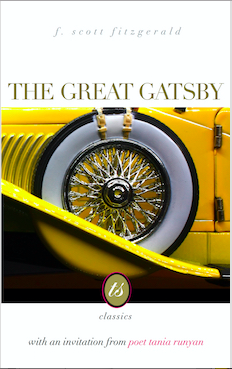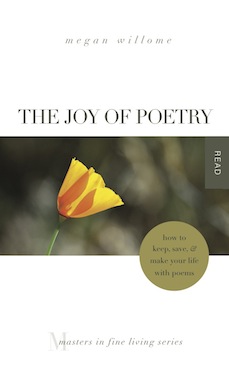The Great Gatsby Poetry
The Great Gatsby is fiction, not a collection of poems, but it might as well be poetry.”
–Tania Runyan, “Invitation to an Epic World,” The Great Gatsby by F. Scott Fitzgerald
In April, Tweetspeak Poetry held The Great Gatsby Book Club, led by Tania Runyan, using the new edition with her introduction. I’d read the book many times, each time hoping to like it. Each time I didn’t, finding no character I particularly enjoy. But this time, with Runyan’s emphasis on the poetry of Fitzgerald’s words along with poetry prompts for each post, I read it more generously. I was able to appreciate the economy of language and the beautiful turns of phrase. I stopped reading it as true crime (it isn’t — it just feels that way) and let the text breathe. Or in this case, I let the text drive.
Oh, my there are such a lot of cars in this story! Cars as symbols and cars as weapons. This story is often heralded as the Great American Novel. And what do Americans love? Cars. The open road. Road trips.
In Gatsby, no one drives far, just from Long Island to New York City and back. But they get in their blue coupés and gorgeous yellow cars and spend afternoons driving into town for drinks and then driving home. As someone who thinks nothing of driving 170 miles one way to meet someone for lunch, I sympathize with Gatsby & Co. Sometimes half the fun of a day trips is choosing which vehicle to drive.
So with this renewed appreciation for the automotive side of the story and a digital edition of the book, I searched the word “car.” What emerged was a treasure trove — not only the poetic potential of the word, but also words with “car” tucked inside them.
Like our narrator, Nick Carraway. Nick Carr-Away. At the end of the story he sells his car and goes far away, back West (meaning Midwest). The word car is also tucked into careful and careless and Gatsby’s caramel-colored suit and Daisy’s incarnation and even the “the whole caravansary” that fell in “like a card house at the disapproval in her eyes.”
In her final Gatsby book club post, Runyan invited us to write a cento. She writes, “Your poem may not be a cento in the strict sense of the word, since Gatsby is a novel, not a poem (but wow, does it come close), but it will operate in much the same way.” Drawing from the four pages of car references I found and typed out, I put together this cento.
The Hard Brown Beetles
kept thudding against the dull light, and it sounded to him like the car that hadn’t stopped
under dripping bare lilac-trees a large open car was coming up the drive
the left rear wheel painted black as a mourning wreath
on the last night, with my trunk packed and my car sold
I crossed deliberately to the other side of the car
wheel and car were no longer joined by any physical bond
I heard a car stop
two cars, one comin’, one goin’, see?
Son-of-a-bitch didn’t even stopus car
I know what kind of car it was!
so we drove on toward death through the cooling twilight
Repairs. George B. Wilson. Cars bought and sold.
_______________
April’s Pages
Poetry
How to Write a Form Poem, by Tania Runyan (hear the poets read)
Hearts on Pilgrimage: poems & prayers, by Jody L. Collins
Swimming Upstream: Middle School Poems, by Kristine O’Connell George
Picture Books and Early Readers
Life on Mars, by Jon Agee
The Wall in the Middle of the Book, by Jon Agee
A New Day, by Brad Meltzer, illus. by Dan Santat
Knuffle Bunny, by Mo Willems (Join us for Children’s Book Club next Friday, May 14!)
Middle Grade and YA
The Mouse and the Motorcycle, by the late and oh so great Beverly Cleary
The Thief (book 1), by Megan Whalen Turner
The Queen of Attolia (book 2), by Megan Whalen Turner
Grownups
All Creatures Great and Small, by James Herriot
Already Toast: Caregiving and Burnout in America, by Kate Washington (wrote a cento from this one’s literary references)
The Great Gatsby: with an invitation from poet Tania Runyan, by F. Scott Fitzgerald
Macbeth (abridged audio version), by William Shakespeare
Made Progress
Lady Bird Johnson: Hiding in Plain Sight, by Julia Sweig
For Discussion
1. What is your experience with The Great Gatsby?
2. Which car that you’ve owned best describes you?
3. Share your April pages. Sliced, started, and abandoned are all fair game.
Photo by durdaneta, Creative Commons, via Flickr. Post by Megan Willome.
Browse more Reading Generously
Browse more Great Gatsby Poetry
I loved this book. As soon as I finished, I began reading it again.”
—David Lee Garrison, author of Playing Bach in the D. C. Metro
- Perspective: The Two, The Only: Calvin and Hobbes - December 16, 2022
- Children’s Book Club: A Very Haunted Christmas - December 9, 2022
- By Heart: ‘The night is darkening round me’ by Emily Brontë - December 2, 2022



Glynn says
Car that best describes me; the one I currently drive, a 2008 Acura TL. It’s now 13 years old, but it still runs well and it still drives like a car. I like my wife’s 2018 Toyota Highlander, but it’s like driving a computer. Driving my Acura is like stubbornly resisting the next new thing.
April reading:
Mystery
Death is Delft by Graham Brack
“A Pretty Folly by Charlie Garratt
Yellow Feet by Glenn McGoldrick
The Zodiac Murder by Roy Lewis
Gone the Next by Ben Rehder
Poetry
How Does He Love Me: Sonnets by Brad Lussier
Mostly Sonnets by James Tweedie
Native Guard by Natasha Trethewey
Shakespeare Reading Project
Richard II
Venus and Adonis
Hamlet
Non-fiction
Ticking Clock: The Inside Story of 60 Minutes by Ira Rosen
I Love You My Child, I’m Abandoning You by Ariela Palace
Fiction
The Shenandoah Road by Lynne Tagawa
Autism Goes to School by Sharon Mitchell
Sandra Heska King says
“like driving a computer.” Ha! My daughter-in-law’s Terrain (?) has it all. My son’s newest pickup (I can’t keep up–he trades his toys in so often) probably does, too. I don’t know. I haven’t ridden in it yet. It’s so high that I don’t even think I could climb up into it.
Megan Willome says
Glynn, I stubbornly resist the new thing by driving a stick shift. I dread the day it dies.
I’ve heard Shakespeare’s “Richard II” is underrated. Do you agree?
Sandra Heska King says
“I let the text drive.” Good one.
This was my first time in this book. It needs more than one read. I have three other FSF books that are part of the set I’ve had for a billion years I want to read now.
My first car was a 1970 Anti-Establish Mint (green) Ford Maverick. My parents got it for me after I finished nursing school in May 1969.
I found this little blurb online: “Anti-Establishment Mint was a standard colour offered by Ford from 1969 – 1972. It was available on many models, including those with a wild west feel – Maverick, Mustang and Pinto. Perhaps Ford felt that the bad pun would appeal to a renegade audience.”
So… make of that as you will. Also, my inlaws-to-be bought me a horse before we even got married.
Today I drive a red Jeep Patriot with leather seats and 4-wheel drive (in Florida) with a sunroof that I seldom open cuz it’s so hot or I just forget. No fancy bells or whistles–no backup camera, which D hates. But we can load the kayaks on it, and I still feel kind of wild in it. Also, the color red makes me think of hope.
Megan Willome says
What a great name for a car color!
Why oh why did your in=laws buy you a horse?
Sandra Heska King says
Cuz D had two horses. Lady, the smaller one, hated me. And riding back then was a thing. It was thought we’d have horses all our lives. We weren’t even married yet. My in-laws were awesome. Wendy was so sweet. When we moved out of the country, we gave her to a handicapped/special riding stable.
Megan Willome says
That is a story, Sandy! One worth at least a poem, if not a short story/essay.
L.L. Barkat says
I’m musing on the idea that with just a quarter turn we can find our generous side. A shift (pun intended) in angle. This feels like a good “mind exercise” to carry forward, for whenever we’re needing to find a way to surface a spirit of generosity. (Which might be more often than we think 😉 )
I loved what you did with the car focus. And your poem made me smile. (Even though it has some hard moments in it.)
Megan Willome says
A quarter turn toward generosity is, I think, a good guideline for all of us.
As to hard moments in the poem, the book certainly has hard moments. It’s not all glitter and cocktails. I do think Fitzgerald’s dialogue is as contemporary as ever.